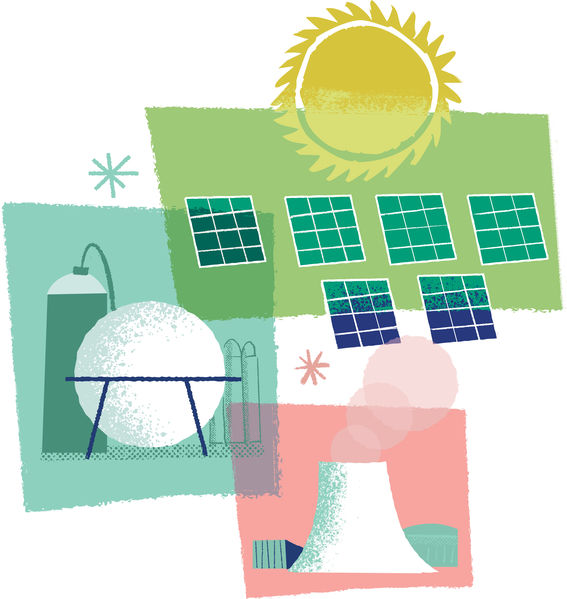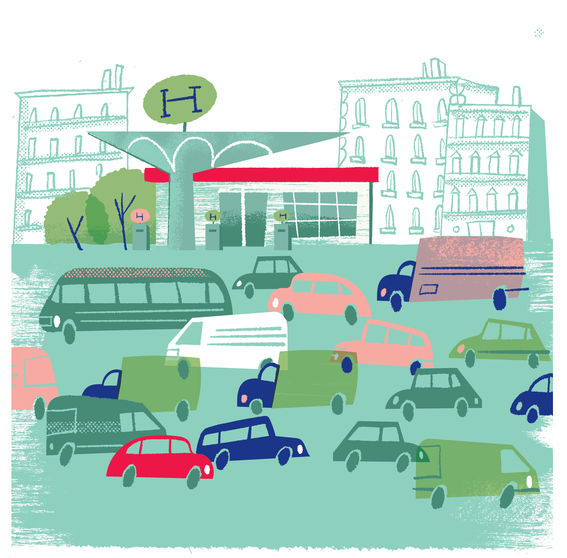The new hydrogen economy training module begins – FITech network received funding for organising the education
The first studies will begin in January 2023.

The year 2023 started off well in the small Finnish town of Inkoo, near Helsinki: Norwegian-based Blastr Green Steel published its plan to invest four billion euros to build a plant in the municipality.
Should all go well, the plant and the integrated hydrogen production facility be up and running before the end of this decade, producing fossil-free steel and employing 1,200 people This would mark one of the largest investments in Finland’s industrial history.
This isn’t the only hydrogen-related project in Finland’s future. Major projects are ongoing or being planned in municipalities such as Raahe, Harjavalta, Pori, Lahti and Kokkola. More broadly, the scope of investments in the EU Hydrogen Strategy amounts to hundreds of billions of euros.
Why the sudden fuss about hydrogen?
It all boils down to the energy crisis, the wind power boom and the climate emergency, says Antti Arasto, vice president of industrial energy and hydrogen at VTT Technical Research Centre of Finland.
‘The carbon neutrality target means that it’s not enough to reduce emissions – we need to get rid of them completely. Green hydrogen alone will not solve the problem, but it will play a major role in the shift.’
From the climate perspective, hydrogen is an ideal fuel: when it’s burned for energy, the only byproduct is water vapour. Hydrogen has been known to be an energy carrier for two centuries, but it’s had a bumpy ride in powering transport. The crash and burn of the Hindenburg airship in 1937 ended the era of zeppelins, and the 1990s hydrogen car boom quickly cooled down when no mass production or fuelling infrastructure materialised.
But there’s been a lot of interest in industrial uses of hydrogen.
The oil industry uses hydrogen to break crude oil into petrol and kerosene, and the chemicals industry uses it to produce ammonia, a key raw material for fertilisers. Fossil-fuel free steel could be producing by using hydrogen to replace coke, a coal-based carbon used for reducing iron ore.
Unfortunately, hydrogen cannot simply be collected. It must be produced. Though there’s no shortage of hydrogen – it’s the most common element in the universe – it does not like solitude. Hydrogen readily binds to other elements in most substances: fossil fuels, water and plant biomass.
Natural gas is by far the most common source material for traditional hydrogen production. In 2020, approximately 90 million tonnes of hydrogen were produced around the world, causing over 800 million tonnes of carbon dioxide emissions – about equivalent to the annual emissions of Great Britain and Indonesia combined.
The carbon footprint of hydrogen depends on how it’s produced. A colour coding system distinguishes the hydrogen based on its source. Hydrogen derived from coal and oil has the highest emissions and is labelled black. Hydrogen extracted from natural gas is called grey. If the carbon dioxide created in the production process is recovered, the hydrogen is labelled blue.
Hydrogen can also be produced by using electricity to break water into hydrogen and oxygen. This method, electrolysis, is simple and emission-free, but it requires energy from electricity. If the electricity is produced with nuclear power, then then emission-free hydrogen is called pink. To be labelled green, hydrogen has to be made using electricity produced from renewable sources, such as wind, solar or hydropower.
A lot of power is needed for electrolysis, so electricity has to be cheap for green hydrogen production and the industries dependent on it profitable. The Inkoo steel plant alone would eat up roughly six terawatt-hours of electricity per year, which is about 7% of Finland’s current total electricity production.
Arasto stresses that green hydrogen production goes hand in hand with increased wind power potential. The price of wind electricity has plummeted in Finland in the 2000s, and onshore wind power has now become the cheapest electricity production method. Finland currently hosts about 1,400 wind power plants, producing around a tenth of the country’s electricity. This share is expected to increase to over a half by 2050.
At the end of this decade, wind power alone could already cover the nation’s entire electricity consumption on a windy day. But what will happen on windless days? Or when the volume of wind power exceeds the demand?

When wind power production exceeds the demand, the extra power can be stored by making hydrogen through electrolysis, which can then be used when wind power is unavailable or insufficient.
In addition to industrial uses, stored hydrogen can serve as fuel for hydrogen engines or in fuel cells that produce electricity out of hydrogen. Toyota plans to release a new hydrogen car later this year, while Airbus is aiming for commercial hydrogen flights in 2035. Stored hydrogen can also be used to produce electricity for the grid with gas turbines, for example, or with Wärtsilä’s engines capable of fast grid balancing.
However, the storage and transport of hydrogen has its challenges. A hydrogen molecule is extremely small: it only contains two hydrogen atoms, each made of a single proton and a single electron. Hydrogen can thus quickly escape through even the smallest holes. One kilogram of hydrogen contains three times as much energy as the same amount of petrol, but since hydrogen is the world’s lightest substance, a kilogram of hydrogen – even if liquefied –takes up a lot more space than a kilogram of petrol.
Storing and using hydrogen can be made easier by refining it into e-fuels. The only other substance need for this is carbon dioxide, which could be collected directly from the chimneys of emission-heavy plants. The simplest electric fuel is methane, or natural gas, which could directly replace the fossil natural gas used in heavy road traffic and shipping, for example.
The price of electric fuels is higher than that of oil or natural gas because a lot of electricity is wasted in hydrogen processes, but Arasto finds price comparison to be partially pointless. ‘Considering the climate goals, fossil fuels are no longer an option for the future.’
The EU has set a goal of covering as much as one-fifth of its energy demand with green or low-carbon hydrogen by 2050. Even before the Ukraine war, the EU Commission had declared that the continent should reduce its energy dependence and that future hydrogen trading should take place in euros instead of dollars.
Realising this plan requires not only massive wind power potential but also an enormous quantity of cheaper and more efficient electrolysers – which means solving the related material challenges.

Aalto’s Associate Professor Tanja Kallio studies the catalyst materials needed for energy storage and for converting it from one form into another. During her long career, there’s never been as much demand or need for her research as there is now.
The cause is clear. ‘The International Energy Agency expects the world’s hydrogen production to increase sixfold by 2050. If that happens, we need to find new solutions for the catalysts in electrolysers,’ Kallio says.
The catalysts speed up the reaction in electrolysers, thus helping store electric power as hydrogen. Precious metals, particularly platinum, are usually used as catalyst materials. The EU has now listed platinum and many other commonly used catalysts as critical raw materials. That designation means that they are either at risk of running out globally – and becoming astronomically expensive as stocks decline – or that they are obtained from geopolitically challenging countries, meaning Europe’s supply is not secure.
That’s why Kallio and her team are developing methods to get as much output from the precious platinum as possible. ‘The ratio of the area of platinum to its volume should be as high as possible. In other words, the catalyst must have all the platinum on its surface. This isn’t a new idea, but its implementation is challenging: as the area becomes larger, the atoms tend to pile up over time. We’ve tried to solve this by increasing the binding energy of the surface carrying the platinum, and that has stabilised the platinum structures.’
Manufacturing and recycling a catalyst both take a lot of energy, and a part of the material is always lost. The group is therefore also looking for ways to extend the lifespan of catalysts.
In addition to developing catalysts that need less platinum, Kallio’s group has also developed platinum-free catalysts made from cheaper, more common materials, such as iron and carbon. These catalysts are fairly long-lived, but they consume a lot of energy, reducing efficiency.
‘Considering the fact that there’s sometimes almost unlimited energy available, they could still offer a better option than platinum catalysts,’ Kallio says.
The largest source of carbon dioxide emissions in Finland is a steel plant in Raahe.
Last year, plant owner SSAB announced that it will speed up its investments, and they aim to make production emission-free by 2030, ten years ahead of schedule. That would cut Finland’s cardon dioxide emissions by as much as 7% in one go.
SSAB is leading a research and development project called ‘Fossil Free Steel’ in which the energy company Fortum is investigating the potential of hydrogen production. Mikko Muoniovaara leads hydrogen business development at Fortum and believes steel production provides the most promising business opening. ‘We could directly replace coke with hydrogen in iron ore reduction.’
Antti ArastoThe hydrogen revolution is a shining example of the fact that education really is worth the investment.
Fortum is part of a national hydrogen cluster comprising 65 companies that aims to accelerate Finland’s hydrogen industry and hydrogen economy by influencing legislation and investment.
In addition to supportive legislation and financing, the industry needs the latest research results and expertise. ‘The research potential of universities is very important to us,’ says Muoniovaara. For example, Fortum and Aalto have jointly studied the option of storing hydrogen in Finnish bedrock.
The cluster was also closely involved in planning the study courses in hydrogen economy offered by the FITech network university. The introductory course was launched at the beginning of this year.
‘We have a lot of expertise here in Finland, but it’s scattered around in different universities. This programme lets us bring it together in one place through remote studies,’ Muoniovaara says.
When VTT Vice President Antti Arasto studied energy technology in Otaniemi two decades ago, green hydrogen was hardly mentioned at all. ‘We’re now moving really quickly towards industrial applications. Many solutions that have been studied at VTT and elsewhere for ten or twenty years are now reality,’ Arasto says.
‘The chain from basic research to applied research, product development and investments in companies, and then to a shift in the whole world’s infrastructure, is tremendously long. The hydrogen revolution is a shining example of the fact that the whole pipeline needs to be invested in, instead of allocating isolated funds at the early and final stages of the process – and that education really is worth the investment.’
Text: Minna Hölttä
Translation: Tiina Leivo
Illustration: Kati Närhi
This article has been published in the Aalto University Magazine issue 32, April 2023.

The first studies will begin in January 2023.

The goal of the project financed by Business Finland is to speed up the development of emission-free marine technology, among other things.

The funding will accelerate research in quantum technology, hydrogen energy and new materials

An exhibition on energy transitions and the challenges and solutions driving our response to the global energy crisis across research and industry.

Donate to ensure we can produce multidisciplinary, creative ideas into real-life applications also in the future.


